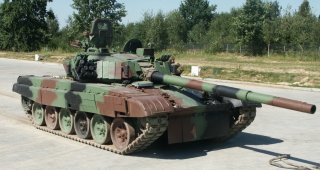Hybrid Army: How Poland Fused Russian and NATO Tanks
These tanks served as a valuable resource for Poland as modernization of the tank into the PT-91 “Twardy.”
Here's What You Need to Remember: Such a tank would likely be cheaper and more cost-effective than the PT-16 or PT-17, while still providing Poland with a tank that is more than capable of fighting anything that isn’t an enemy tank itself. In a way it can be seen as comparable to the similar “budget” T-72B3 upgrade Russia has applied to its tank fleet, albeit less effective as Poland does not have an equivalent heavy ERA package to the Russian Kontakt-5 or Relikt used on T-72B3s, nor new 125mm ammunition.
When the Cold War ended, the Polish Army inherited a massive fleet of T-72s. Most of these tanks were T-72Ms and T-72M1s, which were built in Poland beginning in the 1980s. In the 1990s, these tanks served as a valuable resource for Poland as modernization of the tank into the PT-91 “Twardy.” They also gave the Polish “Bumar” tank plant valuable experience in building their own T-72 upgrade, complete with domestic ERAWA ERA, passive night vision devices, and laser warning systems. The PT-91 also was an export success, scoring a major contract with Malaysia in the 2000s.
However, in addition to modernizing T-72s, Poland adopted the Leopard 2A4 and Leopard 2A5. Adopting Leopard 2s was the first step towards Westernizing the Polish tank fleet, but it split the ammunition supply chain for Polish tanks as the PT-91s and T-72s in Polish service still used 125mm guns. Bumar plant proposed a solution with the PT-16 and PT-17 tanks, which attempted to fit Western tank tech and a 120mm cannons onto the T-72. The goals of the project were to field a secondary frontline tank to the Leopard 2A4 and to keep the Polish tank industry alive.
A new 120mm cannon was the most difficult and critical part of both the PT-16 and PT-17 designs, as the 125mm cannon used on the T-72Ms was considered unsuitable for anti-tank usage. Advanced, high penetration 125mm ammunition is primarily made in Russia, which Poland cannot buy from for clear political reasons.
But most NATO 120mm ammunition is single piece, with the propellant and projectile unified in a single piece. Comparatively, the T-72 was designed to use two-piece ammunition, with the propellant and projectile stored separately. This means that the T-72’s autoloader must be extensively modified to use 120mm projectiles, or simply fully replaced.
For that reason, the PT-16 is largely considered to be a “vaporware” tank as the turret is just said to have a bustle autoloader that works with 120mm NATO rounds without actual details or diagrams of how it works. Sources on who actually makes the gun on the PT-16 also differ; some sources suggest that it might be domestically produced, while others suggest it is a Slovakian or Ukrainian cannon. The tank also includes a litany of improvements that one would expect in a modern tank: the latest thermals, remote weapon systems, laser warning systems, a 1000+ hp engine, and additional passive and active armor packages.
Predictably, the PT-16 didn’t really go anywhere, so the design was refreshed and presented again next year as the PT-17. This time, the turret was said to mount an existing Ukrainian bustle autoloader. The armor layout on the turret is also slightly revised as a result, appearing less boxy. However, it too has not seen orders.
But do the PT-16 and PT-17 even make sense for Poland?
Perhaps not. With the purchases of PAC-3 Patriots and F-35s coming in the near future, the Polish defense budget is likely to have little room for extensive T-72 modernizations. Further development of the Leopard 2PL upgrade would serve Poland well as “anti-armor” tanks, whereas a more conservative upgrade that retains the 125mm gun would work for the remaining T-72s in inventory.
Such an upgrade was shown at MSPO 2018 in the PT-91M2 standard. The PT-91M2 ditches the heavier passive armor upgrades, returning to the Polish ERAWA Explosive Reactive Armor (ERA) tiles on the turret and hull and adding anti-RPG bars on the rear of the hull and turret. The 125mm gun is replaced with a newer Slovak model with improved accuracy, and the hydraulic stabilization mechanism is replaced with a newer and safer electromechanical mechanism. New thermals, auxiliary sights, and engines are also included in the package.
Such a tank would likely be cheaper and more cost-effective than the PT-16 or PT-17, while still providing Poland with a tank that is more than capable of fighting anything that isn’t an enemy tank itself. In a way it can be seen as comparable to the similar “budget” T-72B3 upgrade Russia has applied to its tank fleet, albeit less effective as Poland does not have an equivalent heavy ERA package to the Russian Kontakt-5 or Relikt used on T-72B3s, nor new 125mm ammunition.
Additional information on the PT-16 was taken from “Ekstra Raport Wojsko Technika Obronność. MSPO 2016.”
Charlie Gao studied Political and Computer Science at Grinnell College and is a frequent commentator on defense and national security issues. This article first appeared several years ago.
Image: Wikipedia

